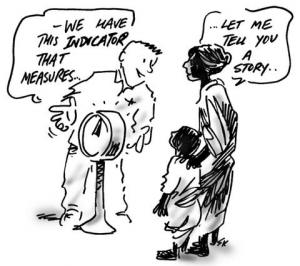Community-based organizations are in a tough position: they work tirelessly towards goals that will have positive social or environmental impacts and they know they create a lot of value for the communities they serve – but, this value is hard to express and recognition from the community is hard to come by. The value created by community-based groups doesn’t get captured very well by standard financial statements because conventional accounting methods do not consider value beyond the financial returns. Expression of the value of social and environmental impacts often falls through the cracks.
So what are community-based organizations to do? How can they express this value to others and get the recognition they deserve? Well, the bad news first: there is no simple and commonly recognized way to measure and show this value. The good news: there are many things that you can do that can show your value! With a thoughtful, well-strategized combination of tools and tactics, organizations can successfully measure and describe the value they are creating in their communities. But remember, taking the steps to show your impact as an organization is best described as a ‘path’ – start simple and gradually build up, and you will eventually find yourself strongly expressing all facets of the value you create. Take a look! Here are the first five things you can do to show your value. You will notice that these five tips focus primarily on qualitative measures, emphasizing descriptions based on a quality or characteristic.
Take a look! Here are the first five things you can do to show your value. You will notice that these five tips focus primarily on qualitative measures, emphasizing descriptions based on a quality or characteristic.
1. Be as clear as possible in describing your vision, mission and strategies. People support you because they value both your vision and the activities you’re doing towards that vision. Think about how your vision and mission motivates others to support you and motivates your own organization. Ask for specific feedback from your members/customers about what your mission and vision mean to them so you can know if your message is getting across clearly.
2. Describe what differentiates you. If you are a social enterprise, brainstorm the ways that you add value when compared with a business that isn’t a social enterprise, or with a program that isn’t a business. What do you do differently? What are you trying out that’s never been tried before? You can make your case stronger by describing evidence to support what you’re saying.
3. Describe and show evidence of the value you create from the perspective of all your stakeholders. Reporting indicators to stakeholders can be a concise way to express value. This approach of using indicators to demonstrate value is optimized when you and your stakeholders collectively identify indicators that you will report on. Everybody who is involved – all of your stakeholders – should see these indicators as important and feasible to portray. These should also be indicators that are important for you to monitor internally, and which also reflect standard indicators in your field (where possible).
4. Tell your story and the stories of those you work with. Don’t discount the power of storytelling! Even if you ‘measure’ and calculate a number, this may be meaningful for only a few – but, a story will reach all. Telling a story doesn’t mean that you aren’t rigorous or business-like. Decision-makers in many fields, including business and government, turn to ‘non-quantitative methods’ (i.e. stories), because of the limitation of numbers. There are a number of resources for using story effectively, including the following publications:
- Community Foundations of Canada. The Storied Organization: Communicating Value, Inviting Caring, Celebrating Success. Discussion Paper, Storytelling In Voluntary Sector, Ottawa: Community Foundations of Canada, 2002.
- Rick Davies and Jess Dart. The Most Significant Change (MSC) Technique: A Guide to Its Use. April 2005. MSC is a technique to collect and systematically choose stories to understand impact. The guide is developed for international development projects). Click here to view guide.
5. Create a map of how you are influencing change. Impact mapping is a valuable exercise and tool for planning, guiding what you monitor, and expressing your value as a community-based organization. It helps you define your social, environmental, and/or cultural mission in more detail and really understand the impact and outcomes your work has in the community.
“How can I start mapping?”, you may ask…
A great first step is the “Why You Matter” Impact Mapping Worksheet featured on the Demonstrating Value website. You can use this worksheet to:
- Describe the activities you do to make a difference, and what the difference looks like.
- Explore methods you can use to map out connections between your activities and what you want to accomplish with your mission.
In this worksheet you will also find templates for three different mapping methods, including logic models, outcome mapping, and theory of change. Happy mapping!
(Stay tuned for five more ways to show your impact in our post next week.)
